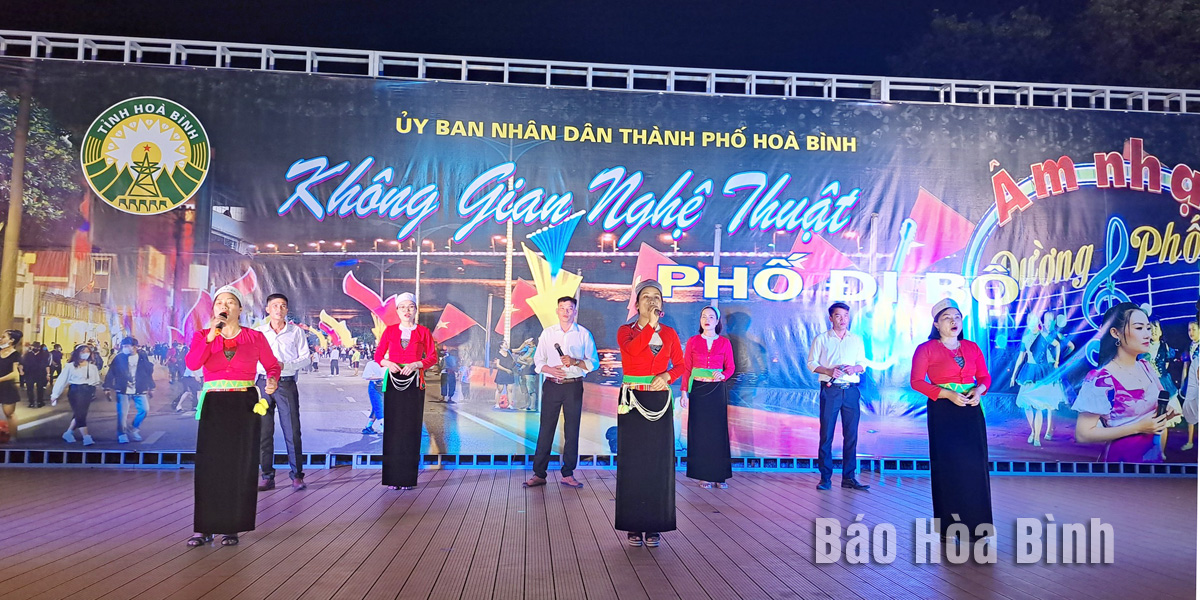
(HBO) - According to information from the People's Committee of Hoa Binh City, in the evening of October 26th, after performing the fish praying ceremony and releasing flower lanterns within the framework of the first Fish and Shrimp Festival of DA River in Hoa Binh province, Hoa Binh city officially opens Da Giang walking street with many attractive activities.
A special musical performance performed at Da Giang walking street, Hoa Binh city during the trial operation.
The opening ceremony location is at the main stage of the walking street (next to AP Plaza Hotel). In the opening program, there are many unique cultural and artistic performances such as lion dance, Muong gong performance... In particular, there is the participation of many famous singers from Hanoi and Ho Chi Minh City.
Opening and putting the walking street into operation is to create a healthy environment and attractive tourism destination, meeting and serving the needs of sightseeing, entertainment, culinary enjoyment, and shopping of the residents and tourists when coming to Hoa Binh, contributing to promoting and introducing the image of Hoa Binh province and city, thereby it helps promote the development of tourism, trade and services.
Hoa Binh province has carried out multiple programmes and initiatives to revive its cultural heritage which has gradually fallen into oblivion through the ebbs and flows of history.
The most prominent and defining feature in the prehistoric era of Hoa Binh is the Hoa Binh Culture. The Culture was first discovered in Hoa Binh. The significant prehistoric culture represents not only Vietnam but also Southeast Asia and southern China. Through excavations of cave sites in the limestone regions of Hoa Binh, French archaeologist M. Colani introduced the world to a "Stone Age in Hoa Binh province – Northern Vietnam" in 1927. On January 30, 1932, the First Congress of Far Eastern Prehistorians, held in Hanoi, officially recognised the Hoa Binh Culture.
Known as the "Land of Epic History”, Hoa Binh province, the gateway to Vietnam’s northwest, boasts a strategic location and a unique cultural tapestry woven by its ethnic minority communities.
The People's Committee of Luong Son District recently held a ceremony to receive the certificate recognizing Sau Communal House in Thanh Cao Commune as a provincial-level historical and cultural site.
Recognising the importance of cultural heritage preservation in protecting and promoting the value system of Vietnamese culture, and serving socio-economic development in the new period, Party committees and local administrations in Hoa Binh province have identified it as a key task in the cultural development strategy. The province has been making efforts in mobilising resources, creating consensus among people and engaging ethnic communities in preserving and promoting cultural identity.
Hoa Binh province has captured growing attention both domestically and internationally for its distinctive cultural heritage and rich history. Most notably, it has been renowned for its famous Hoa Binh culture, considered the cradle of ancient Vietnamese civilisation. Looking ahead to significant milestones in 2025 and the 140th anniversary of province establishment in 2026, Hoa Binh Newspaper presents a comprehensive overview of the province's development across economic, social, cultural, tourism, and security domains.



